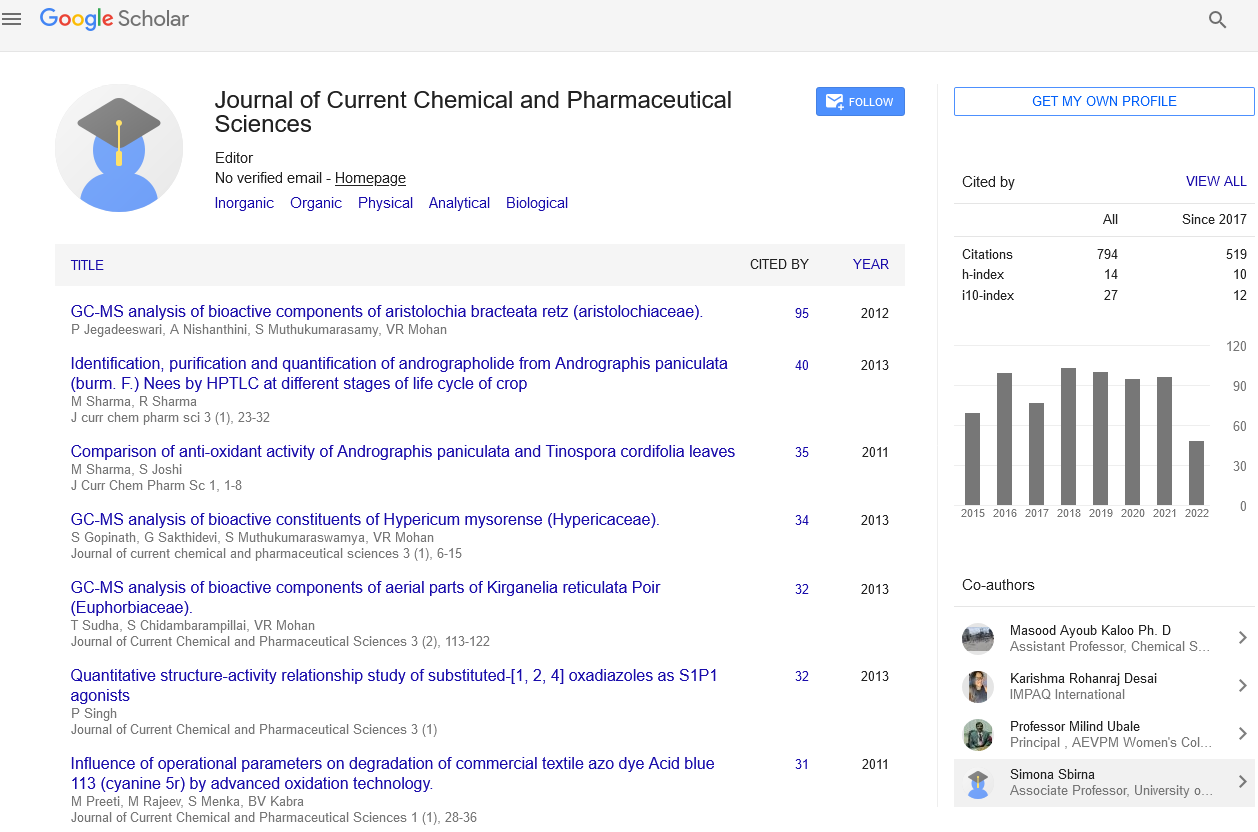Current opinion
, Volume: 12( 1)The Neurotoxicity of Caffeine is Potentiated by Phenylpropanolamine in Rats
- *Correspondence:
- MS Murthy Department of pharmaceutical sciences, St. Vincent University, Victoria, Australia. E-mail: asmurthm@edu.org
Received: January 07, 2022, Manuscript No. JCCPS -22-004; Editor assigned: January 12, 2022, PreQC No. JCCPS -22-004 (PQ); Reviewed: January 14, 2022, QC No JCCPS -22-004; Revised: January 20, 2022, Manuscript No. JCCPS -22-004 (R); Published: January 27, 2022, DOI: 10.4172/JCCPS 2277-2871.004
Citation: Murthy MS. The Neurotoxicity of Caffeine is potentiated by Phenylpropanolamine in. J Curr Chem Pharm Sc. 2022; 12(1):004.
Abstract
Phenylpropanolamine (PPA) is a sympathomimetic drug (structurally related to ephedrine and amphetamine) which is widely used as a component in over-the-counter nasal decongestants and anorexiant medications. Recently, it has also begun to appear in “street” stimulants or amphetamine “look-alike” products. As public exposure to PPA increased, many complications were reported, including nausea, tremors, dizziness, palpitations, convulsive seizures, anxiety, agitation, hallucinations, and psychotic reactions.1-3 Phenylpropanolamine has therefore become a controversial drug, k7 and there is much debate about the risk [1]:benefit ratio of the drug. Ideally, debates about the risks and benefits should be settled on the basis of scientific data. For PPA this is difficult to do because most reports describing PPA toxicity is anecdotal, consisting of only one case or of a few cases. Furthermore, most reports of PPA toxicity have occurred following use of combination products containing other stimulants, usually caffeine and ephedrine. This makes it difficult to judge the validity of reports of PPA toxicity since the adverse reactions may be due to caffeine or other drugs or due to synergistic effects [2]. Despite the FDA ruling in 1983 to ban caEeine
Introduction
Phenylpropanolamine (PPA) is a sympathomimetic drug (structurally related to ephedrine and amphetamine) which is widely used as a component in over-the-counter nasal decongestants and anorexia medications. Recently, it has also begun to appear in "street" stimulants or amphetamine "look-alike" products. As public exposure to PPA increased, many complications were reported, including nausea, tremors, dizziness, palpitations, convulsive seizures, anxiety, agitation, hallucinations, and psychotic reactions.1-3 Phenylpropanolamine has therefore become a controversial drug, k7 and there is much debate about the risk: benefit ratio of the drug. Ideally, debates about the risks and benefits should be settled on the basis of scientific data. For PPA this is difficult to do because most reports describing PPA toxicity is anecdotal, consisting of only one case or of a few cases. Furthermore, most reports of PPA toxicity have occurred following use of combination products containing other stimulants, usually caffeine and ephedrine. This makes it difficult to judge the validity of reports of PPA toxicity since the adverse reactions may be due to caffeine or other drugs or due to synergistic effects. Despite the FDA ruling in 1983 to ban caEeine:PPA combinations, their concomitant use will continue to occur because users can combine PPA products with beverages and other products containing caffeine .
Caffeine concentrations were determined by HPLC. Briefly, for serum, CSF, and dialysis buffer, this involved addition of 10 pL of internal standard (8-chlorothecphylline, 2 mgimL) to 50-pL samples, followed by 150 pL of acetonitrile to precipitate the proteins, and chromatograph;y of 10 pL of the supernatant . To determine caffeine in brain, 0.5-g samples of tissue were used and 25 pL of internal standard solution and 1 mL of acetonitrile were added. The mixture was homogenized in a tissue homogenizer (Wheaton Instruments, Millville, NJ) and centrifuged and 10 pL of the supernatant was injected onto the column. Chromatography was on a reversed-phase C, 5p, alumina column (Alcoa, New Kensington, PA) with acetonitrile and 1% glacial acetic acid in a 10:90 mixture as the mobile phase. The flow rate was 0.8 niLimin and detection was at 280 nm. The coefficient of variation of the assay was 2% in the concentration range 50-750 mg/L or mg/kg, and the detection limit was -0.5 mgiL. Catfeine metabolites (theophylline, theobromine, 1-methyluric acid, 1, 3-dimethyluric acid) could be separated in all samples by changing the column (Vad-U-Pak C,
The results of this investigation show that caffeine concentrations in serum, brain, and CSF at onset of maximal seizure are independent of drug infusion rate in the range tested. These sites can therefore be considered to be in rapid pseudoequilibrium with the site of action of caffeine neurotoxicity and do not support a previous report15 that functional tolerance to CNS excitation develops after caffeine administration.
These latter authors found that caffeine concentrations at onset of maximal seizures increased with decreasing infusion rate. An increase in the concentration of drug required to elicit a defined pharmacologic effect with increasing time of exposure to the drug is characteristic of functional tolerance. Caffeine concentrations were determined by HPLC. Briefly, for serum, CSF, and dialysis buffer, this involved addition of 10 pL of internal standard (8-chlorothecphylline, 2 mgimL) to 50-pL samples, followed by 150 pL of acetonitrile to precipitate the proteins, and chromatograph;y of 10 pL of the supernatant . To determine caffeine in brain, 0.5-g samples of tissue were used and 25 pL of internal standard solution and 1 mL of acetonitrile were added. The mixture was homogenized in a tissue homogenizer (Wheaton Instruments, Millville, NJ) and centrifuged and 10 pL of the supernatant was injected onto the column. Chromatography was on a reversed-phase C, 5p, alumina column (Alcoa, New Kensington, PA) with acetonitrile and 1% glacial acetic acid in a 10:90 mixture as the mobile phase. The flow rate was 0.8 niLimin and detection was at 280 nm.
